抑制盐诱导金纳米颗粒聚集的新型比色法检测聚丙烯纳米塑料
IF 5.9
3区 工程技术
Q1 CHEMISTRY, MULTIDISCIPLINARY
Journal of Industrial and Engineering Chemistry
Pub Date : 2025-05-03
DOI:10.1016/j.jiec.2025.04.059
引用次数: 0
摘要
基于纳米材料的比色传感技术得到了广泛的研究,但其在纳米塑料检测中的应用仍不发达。本研究建立了一种非破坏性比色法,通过抑制盐诱导的金纳米颗粒(AuNP)聚集来检测聚丙烯纳米塑料(纳米pp)。该方法利用纳米pp的静电和空间稳定效应来防止NaCl (0.05-0.10 M)引发的聚集,从而在520 nm处产生可量化的局部表面等离子体共振(LSPR)变化。在没有纳米pp的情况下,AuNP的快速聚集导致了从红到灰的颜色转变和LSPR信号的丢失。相反,增加纳米pp浓度可以有效地恢复分散并恢复520 nm峰。Zeta电位分析显示,纳米pp表面电荷从-45.97 mV转变为+ 39.27 mV,从而与带负电荷的AuNP发生静电相互作用。使用稳定剂或单独使用甲苯的对照实验未能抑制聚合,证实了纳米pp存在时的稳定作用。根据NaCl浓度的不同,检出限为0.15 ~ 1.26 mL (9.95 ~ 51.08 mg/L), 1 min即可完全检出。该技术为传统的光谱方法提供了一种快速、灵敏、经济的替代方法,并为将比色传感扩展到其他水环境中的纳米塑料奠定了基础。本文章由计算机程序翻译,如有差异,请以英文原文为准。

Novel colorimetric detection of polypropylene nanoplastic via inhibition of salt-induced aggregation of gold nanoparticle
Colorimetric sensing using nanomaterials is widely studied, yet its application to nanoplastic detection remains underdeveloped. In this study, a non-destructive colorimetric method was developed to detect polypropylene nanoplastic (nano-PP) by inhibiting salt-induced aggregation of gold nanoparticles (AuNP). The method utilizes the electrostatic and steric stabilization effects of nano-PP to prevent aggregation triggered by NaCl (0.05–0.10 M), resulting in a quantifiable change in the localized surface plasmon resonance (LSPR) at 520 nm. Without nano-PP, rapid AuNP aggregation caused a red-to-gray color transition and LSPR signal loss. In contrast, increasing nano-PP concentrations effectively restored dispersion and recovered the 520 nm peak. Zeta potential analysis revealed a shift in nano-PP surface charge from –45.97 mV to + 39.27 mV, enabling electrostatic interaction with negatively charged AuNP. Control experiments using stabilizing agent or toluene alone failed to inhibit aggregation, confirming that stabilization occurred specifically in the presence of nano-PP. The detection limit ranged from 0.15 to 1.26 mL (9.95–51.08 mg/L), depending on NaCl concentration, with full detection achieved in 1 min. This technique offers a rapid, sensitive, and cost-effective alternative to conventional spectroscopic methods and establishes a foundation for extending colorimetric sensing to other nanoplastics in aqueous environments.
求助全文
通过发布文献求助,成功后即可免费获取论文全文。
去求助
来源期刊
CiteScore
10.40
自引率
6.60%
发文量
639
审稿时长
29 days
期刊介绍:
Journal of Industrial and Engineering Chemistry is published monthly in English by the Korean Society of Industrial and Engineering Chemistry. JIEC brings together multidisciplinary interests in one journal and is to disseminate information on all aspects of research and development in industrial and engineering chemistry. Contributions in the form of research articles, short communications, notes and reviews are considered for publication. The editors welcome original contributions that have not been and are not to be published elsewhere. Instruction to authors and a manuscript submissions form are printed at the end of each issue. Bulk reprints of individual articles can be ordered. This publication is partially supported by Korea Research Foundation and the Korean Federation of Science and Technology Societies.

 求助内容:
求助内容: 应助结果提醒方式:
应助结果提醒方式:


